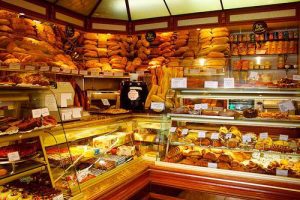Case study Chapter 12 (Linear programming)
A share is refferred to as a unit of owner ship which represents an equal proportion of a company’s capital. A share entities the shareholders to an equal claim on profit and loss of company. Dr. Ritam wants to invest at most ₹ 12,000 in two type of shares A abd B. According to the rules, she has to invest at least ₹ 2000 in share A and at least ₹ 4000 in share B. If the rate of interest on share A is 8% per annum and on share B is 10% per annum.(Case study linear programming 4)

Based on above information answer the following question.
(i) (a) If Dr. Ritam invest ₹ x in share A, then find the inequality for it .
(b) If she invest ₹ y in share B, then find inequality for it.
(ii) (a) If total interest recieved by Dr. Ritam from both type of shares is represented by Z, then represent Z in term of x and y.
(b) To maximise interest to both type of share, find the invested amount on both shares A & B.
Solution: Amount invest by Dr.Ritam in A share = ₹ x
Amount invest by Dr.Ritam in B share = ₹ y
(i) (a) Since she has to invest at least ₹ 2000 in share A
∴ x ≥ 2000
(b) Since, she has to invest at least ₹ 4000 in share B
∴ y ≥ 4000
(ii) (a) Interest on share A = x×8/100 = ₹ 2x/25
Interest on share B= y×10/100 = ₹ y/10
∴ Her total interest = Z = ₹![]()
(b) WEe have,
Z = ![]() which is to be maximised under constraints
which is to be maximised under constraints
x ≥ 2000
y ≥ 4000
and x + y ≤ 12000

Here, ABC be bounded feasible region with corner points A(2000, 10000), B(8000, 4000), C(2000, 4000).
Now we evaluate Z at each corner points.
Corner point Z = (2x/25 + y/10)
A(2000, 10000) 1160 ← Max
B(8000, 4000) 1040
C(2000, 4000) 560
i.e. For maximum interest x = ₹ 2000, y = ₹ 10000
Some Other Case Study
Aeroplane is an important invention for three reasons.It shortens travel time, is more comfortable and facilitates the transport of heavy cargo.(Case study linear programming 5 )
An aeroplane can carry a maximum of 200 passengers.
A profit of ₹ 400 is made on each executive class ticket and profit of ₹ 300 is made on each economy class ticket. The airline reserves at least 20 seats for executive class. However at least 4 times as many passenger prefer to travel by economy class then by executive class.
(i) If x tickets of executive class and y tickets of economy class be sold, then which of the following is correct ?
(a) x + y = 200 (b) x + y ≥ 200
(c) x + y > 200 (d) x + y ≤ 200
(ii) Which pair of constraints are correct ?
(a) x ≥ 40 and x ≤ 20 (b) x ≤ 40 and x ≥ 20
(c) x < 40 and x > 20 (d) x = 40 and x ≥ 40
(iii) If profit earned by airlines is represented by Z, then Z is given by
(a) Z = 300x + 400y (b) Z = 400x + 300y
(c) Z = x + y (d) Z = 4x + 3y
(iv) Airlines are interested to maximise the profit. For this to happen the value of x and y i.e. number of executive class ticket and economy class ticket to be sold should be respectively.
(a) 40, 160 (b) 160,40
(c) 20, 180 (d) 180, 20
(v) The maximum profit earned by airlines is
(a) ₹ 68000 (b) ₹ 70000
(c) ₹ 64000 (d) ₹ 62000
Solution: For solution click here
Question: A bakery in an establishment produces and sells flour-based food baked in an oven such as bread, cakes, pastries, etc.
Ujjwal cake store makes two types of cake. First kind of cake requires 200 g of flour and 25 g of fat and 2nd type of cake requires 100 g of flour and 50 g of fat.(Case study linear programming 3)

(i) If bakery makes x cakes of first type and y cakes of 2nd type and it can use maximum 5 kg flour, then which of the following constraint is correct ?
(a) 2x + y ≥ 50 (b) x + y ≤ 50
(c) 2x + y ≤ 50 (d) 2x + y = 50
(ii) If Bakery can use maximum 1 kg fat, then which of the following is correct ?
(a) x + 2y ≥ 40 (b) x + y ≥ 40
(c) x + 2y = 40 (d) x + 2y ≤ 40
(iii) If the total number of cakes made by bakery is represented by Z, then Z is equal to
(a) Z = 2x+y (b) Z = x + 2y
(c) Z = x + y (d) Z = 2x + 3y
(iv) the maximum number of total cakes which can be made by bakery, assuming that there is no shortage of ingredients used in making the cakes is
(a) 40 (b) 30
(c) 20 (d) 25
(v) The number of first and second type of cakes are respectively
(a) 10, 20 (b) 20, 10
(c) 20, 20 (d) 10, 25
Solution: For solution click here
Question: Owner of a whole sale computer shop plans to sell two type of computers – a desktop and portable model that will cost ₹ 25000 and ₹ 40000 respectively.(Case study linear programming 1 chapter 12 class 12)

Based on the above information answer the question
(i) If the number of desktop model and portable model in the stock are x and y , to get maximum profit after selling and store of shop have capacity to keep computer not exceed 250 units, then which of the following is correct ?
(a) x + y = 250 (b) x + y > 250
(c) x + y ≥ 250 (d) x + y ≤ 250
(ii) If owner of shop does not want to invest more than ₹ 70 lakhs on both type of computer then which of the following is correct ?
(a) x + y ≤ 1000 (b) 5x + 8y ≥ 1400
(c) 5x + 8y ≤ 1400 (d) 5x + 8y = 1400
(iii) If the profit on the desktop model is ₹ 4500 and portable model is ₹ 5000, the profit Z is expressed as
(a) Z = 45x + 50y (b) Z = 4500x+5000y
(c) Z = 5000x+4500y (d) Z = x + y
(iv) The number of units of each type of computers which the owner of shop have in stock to get maximum profit is
(a) x = 250, y =100 (b) x = 100, y = 250
(c) x = 200, y = 100 (d) x = 200, y = 50
(v)The maximum profit is
(a) ₹ 11,25,000 (b) ₹11,15,000
(b) ₹ 11,80,000 (d) ₹11,50,000
Solution: For solution click here
Question: A dealer Ramprakash residing in a rural area open a shop to start his bussiness. He wishes to purchase a number of ceiling fans and table fans. A ceiling fan costs him ₹ 360 and table fan costs ₹ 240.
Based on the above information answer the question(Case study linear programming 2)

(i) If Ramprakash purchases x ceiling fans, y table fans. He has space in his store for at most 20 items, then which of the following is correct ?
(a) x + y = 20 (b) x + y > 20
(c) x + y < 20 (d) x + y ≤ 20
(ii) If Ramprakash has only ₹ 5760 to invest on both types of fan, then which of the following is correct ?
(a) x + y ≤ 5760 (b) 360 x + 240 y ≤ 5760
(c) 360 x + 240 y ≥ 5760 (d) 3 x + 2y ≤ 48
(iii) If he expects to sell ceiling fan at a profit of ₹ 22 and table fan for a profit of ₹ 18, then the profit is expressed as
(a) Z = 18x + 22y (b) Z = 22x + 18y
(c) Z = x + y (d) Z ≤ 22 x +18 y
(iv) If he sells all the fans that he buys, then the number x, y of both the type fans in stock to get maximum profit is
(a) x = 10, y = 12 (b) x = 12, y = 8
(c) x = 16, y = 0 (d) x = 8, y = 12
(v) The maximum profit after selling all fans
(a) ₹ 360 (b) ₹ 560
(c) ₹ 1000 (d) ₹ 392
Solution: For solution click here

